General
Understanding Salary for Designers: An In-Depth Tutorial on Maximizing Your Earnings
Overview
The article’s primary focus is on strategies that designers can implement to maximize their earnings in 2025.
- Understanding salary trends
- Geographical influences
- Effective negotiation techniques
- Addressing the gender pay gap
- Investing in continuous learning
These elements are highlighted as crucial for designers aiming to enhance their financial outcomes in a competitive job market. By mastering these strategies, designers can position themselves advantageously and navigate the complexities of today’s employment landscape.
Introduction
In the dynamic world of design, understanding salary trends is crucial for professionals aiming to maximize their earning potential. As we approach 2025, various factors—including specialization, geographical location, and the impact of remote work—are reshaping the financial landscape for designers across the industry.
The high demand for UX/UI designers, coupled with the persistent gender pay gap, reveals a complex picture of compensation. This article delves into key insights and trends influencing designer salaries, offering a comprehensive breakdown of earnings by role, the geographical disparities that affect pay, and strategies to navigate negotiations effectively.
With the right knowledge and skills, designers can position themselves for success in an increasingly competitive market.
Overview of Designer Salaries: Key Insights and Trends
In 2025, the salary for designers is shaped by various factors, including experience, specialization, and the evolving market landscape. Recent compensation guides indicate that salaries for designers in the U.S. typically range from $50,000 to over $120,000, reflecting the diversity of roles and geographic locations. Notably, UX/UI professionals are at the forefront, often commanding higher salaries due to the growing demand for user-centered solutions in digital products.
For example, the average salary for a UX researcher is around $91,000 annually, underscoring the critical importance of user research in the design process.
The emergence of remote work has also transformed the salary landscape for designers and other creatives. With the ability to work from any location, professionals can now negotiate salaries based on a broader market perspective rather than being confined to regional standards. This transition not only amplifies earning potential but also provides greater flexibility in job opportunities.
As David Mercado, a writer and marketer, notes, understanding the market environment is vital for creatives aiming to optimize their income and leverage remote work opportunities effectively.
Statistics reveal that approximately 60% of graphic artists hold a bachelor’s degree, while 21% enter the field without formal education, indicating that educational background can influence designer salaries. As the industry continues to evolve, staying informed about salary trends is essential for creators looking to enhance their earnings in a competitive landscape. Case studies from 2025 illustrate these trends, demonstrating how companies are adapting to the shifting environment.
For instance, comprehensive campaigns developed by agencies like WonderEight for brands such as Miranda and Quaker Oats highlight the importance of strategic planning in boosting brand engagement and loyalty. These successful initiatives not only showcase the value of skilled creators but also suggest that effective aesthetics can lead to increased demand for such professionals, thereby positively impacting compensation trends.
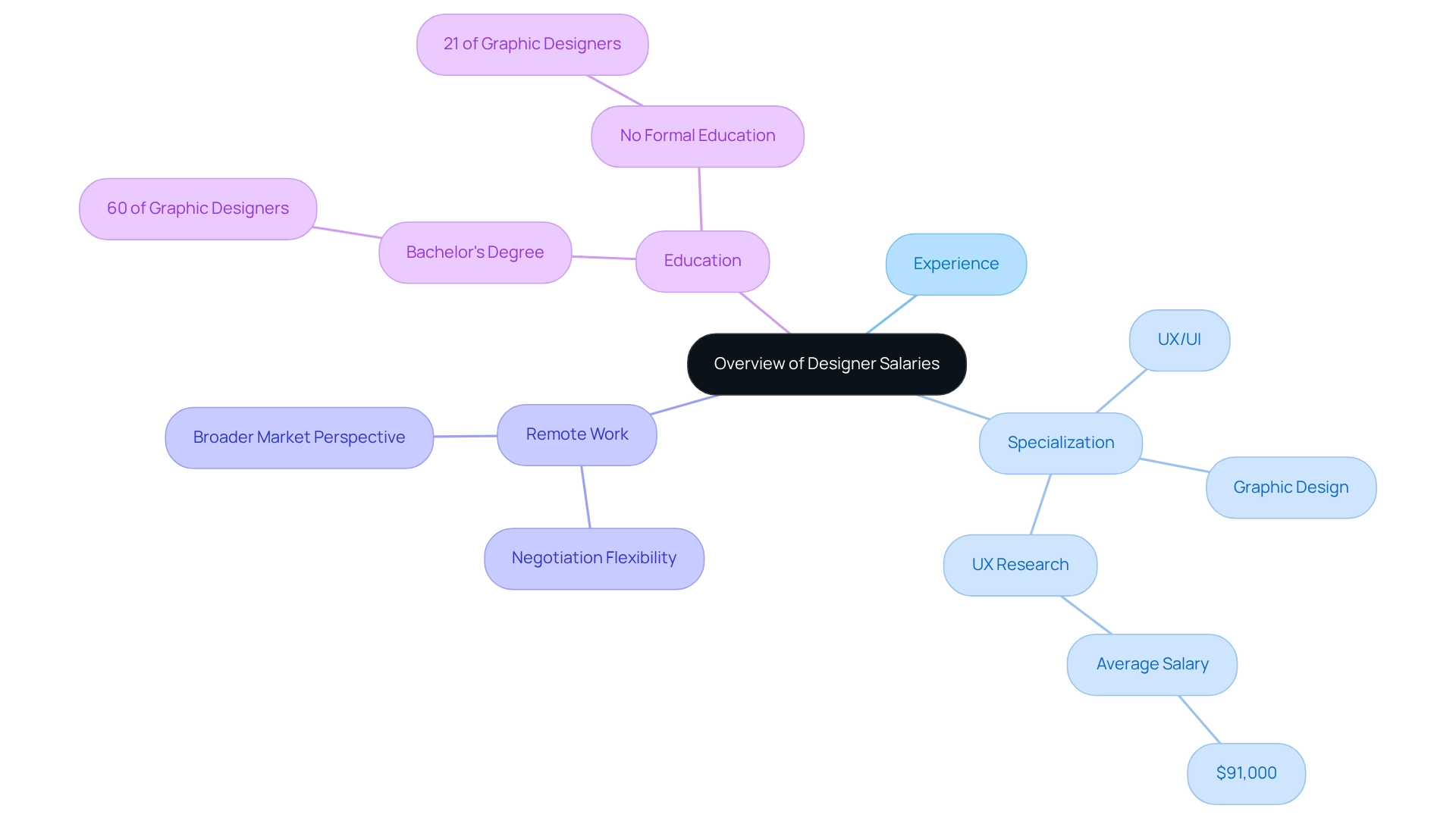
Salary Breakdown by Design Role: Graphic, UX, and Web Designers
In 2025, the compensation landscape for creators reveals significant variations in designer salaries, influenced by specialization and experience. A comprehensive analysis of typical earnings for essential design roles indicates the following:
-
Graphic Artists: The average income for graphic artists ranges from $50,000 to $80,000, with entry-level positions starting at approximately $40,000. Notably, the 90th percentile annual income for graphic artists can reach up to $100,450, highlighting the substantial earning potential for those who excel in their craft.
-
UX Professionals: UX professionals command higher salaries, averaging between $80,000 and $130,000. In senior roles, earnings can exceed $150,000, reflecting the critical role UX plays in enhancing user experiences and driving business success.
-
Web Creators: Typically, web creators earn between $60,000 and $100,000, depending on their skill set and experience level. This range underscores the importance of specialization in maximizing salary potential.
Understanding the salary landscape for designers is crucial for professionals aiming to negotiate their worth in the job market. Furthermore, case studies from WonderEight, such as the successful campaigns developed for Mirinda and Quaker Oats, illustrate how effective branding and design can enhance visibility and engagement. Success stories, including the brand identity enhancement for Castania and the digital campaign for Motorola, demonstrate measurable outcomes, further emphasizing the importance of skilled professionals in achieving business results.
As the industry evolves, staying informed about compensation trends and the impact of specialization will empower creators to make strategic career decisions.
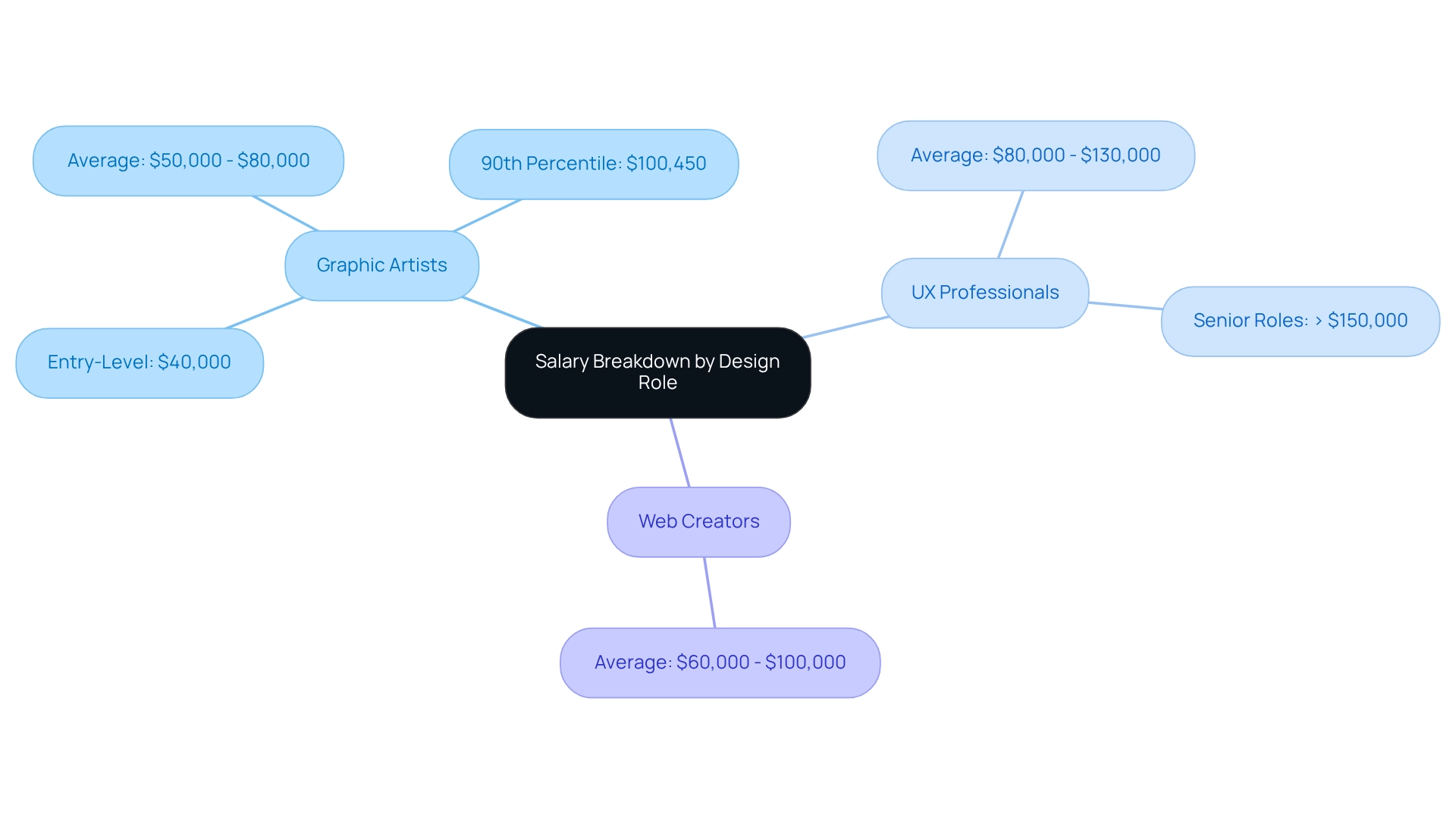
Geographical Influence on Designer Salaries: A Comparative Analysis
Geographical position significantly influences the earnings of creators, with professionals in major urban centers often earning considerably more than those in smaller towns or rural areas. For instance, in 2025, UX designers in San Francisco command an average income of approximately $130,000, whereas their counterparts in Austin earn about $100,000. This 20-30% income disparity underscores the critical role that cost of living and market demand play in compensation negotiations.
Moreover, the compensation landscape varies greatly across different cities. Designers in metropolitan areas such as New York and Los Angeles also enjoy higher compensation compared to those in less populated regions. The 2025 Salary Guide reveals that the total average remuneration for graphic professionals in the U.S. stands at $78,845, with a median income of $65,000 and a range from $40,000 to $135,000.
This data clearly illustrates the importance of geographical context when evaluating potential earnings. As noted by Payscale, “Here’s the information on product creators’ earnings supplied by Payscale and Glassdoor,” further emphasizing the necessity for creators to consider location in their compensation expectations.
Furthermore, the rise of freelancing among product creators has introduced additional complexity to compensation discussions. Freelance product creators, who value the flexibility of choosing their clients and project rates, report an average income of $73,926, inclusive of additional compensation. This trend highlights how geographical factors can influence not only compensation expectations but also career satisfaction and opportunities.
The ability to work autonomously allows creatives to tailor their careers according to personal preferences, ultimately impacting their overall earnings.
In conclusion, understanding the geographical impact on salary for designers is crucial for making informed career decisions. As the market continues to evolve, remaining aware of these dynamics will empower designers to maximize their earnings effectively.
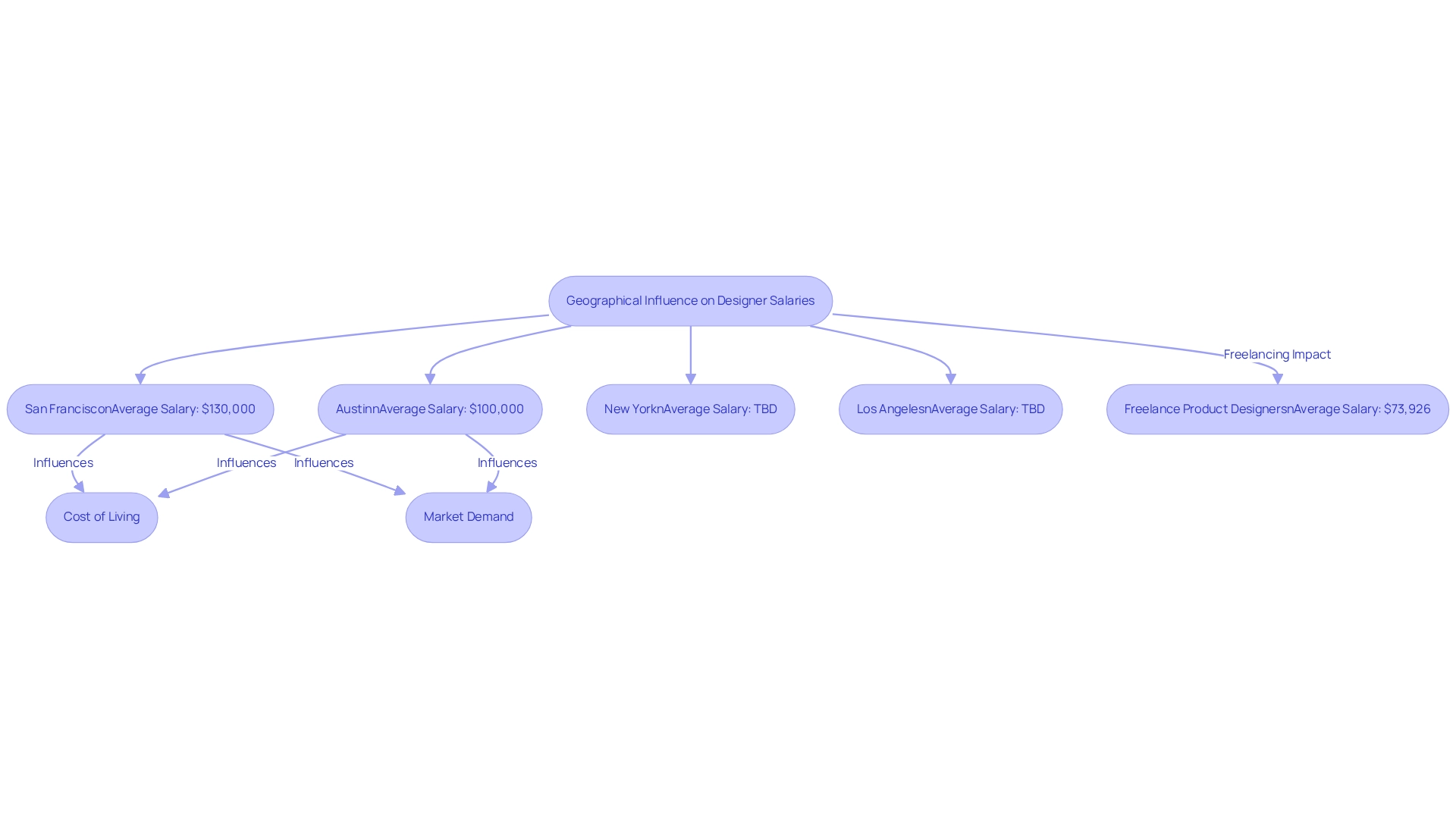
Gender Pay Gap in Design: Understanding the Disparities
The gender pay gap represents a significant challenge within the creative sector. As of 2025, data indicates that women in design roles earn approximately 83 cents for every dollar earned by their male counterparts, highlighting a persistent disparity that necessitates systemic change. This gap is particularly evident in senior positions, where women face not only wage differences but also obstacles to career advancement.
At the executive level, women earn merely $0.72 for each dollar earned by male executives, underscoring the underrepresentation of women in leadership roles and the ongoing struggle for pay equity. Notably, Hispanic women and American Indian and Native Alaskan women earn about $0.91 for every dollar earned by their male counterparts at the executive level, reflecting the specific challenges faced by these groups.
Addressing these disparities requires a collaborative approach. Employers must commit to equitable pay practices and actively foster women’s career development through mentorship and training programs. Success stories from organizations that have embraced such initiatives reveal that cultivating an inclusive environment can lead to enhanced salary outcomes for designers, particularly for women.
Organizations prioritizing gender equity in their hiring and promotion processes have witnessed a notable increase in female representation in leadership positions, which in turn contributes to achieving a more balanced salary structure.
Expert opinions further stress the significance of upskilling and career progression. Industry leaders highlight that a social media manager transitioning to a community manager role could potentially earn $50,000 more annually, showcasing the financial benefits of career advancement and skill enhancement. Additionally, companies like Payscale are empowering over 65% of the Fortune 500 with their compensation management services, which are crucial for promoting equitable pay across various sectors.
By focusing on these strategies, the design sector can endeavor to close the gender pay gap and ensure that all professionals, irrespective of gender, receive fair compensation for their contributions. The report titled ‘Gender Pay Gap by Job Level‘ reinforces the issue of women’s underrepresentation in leadership roles and the associated pay disparities at every level, indicating significant barriers to advancement and pay equity.
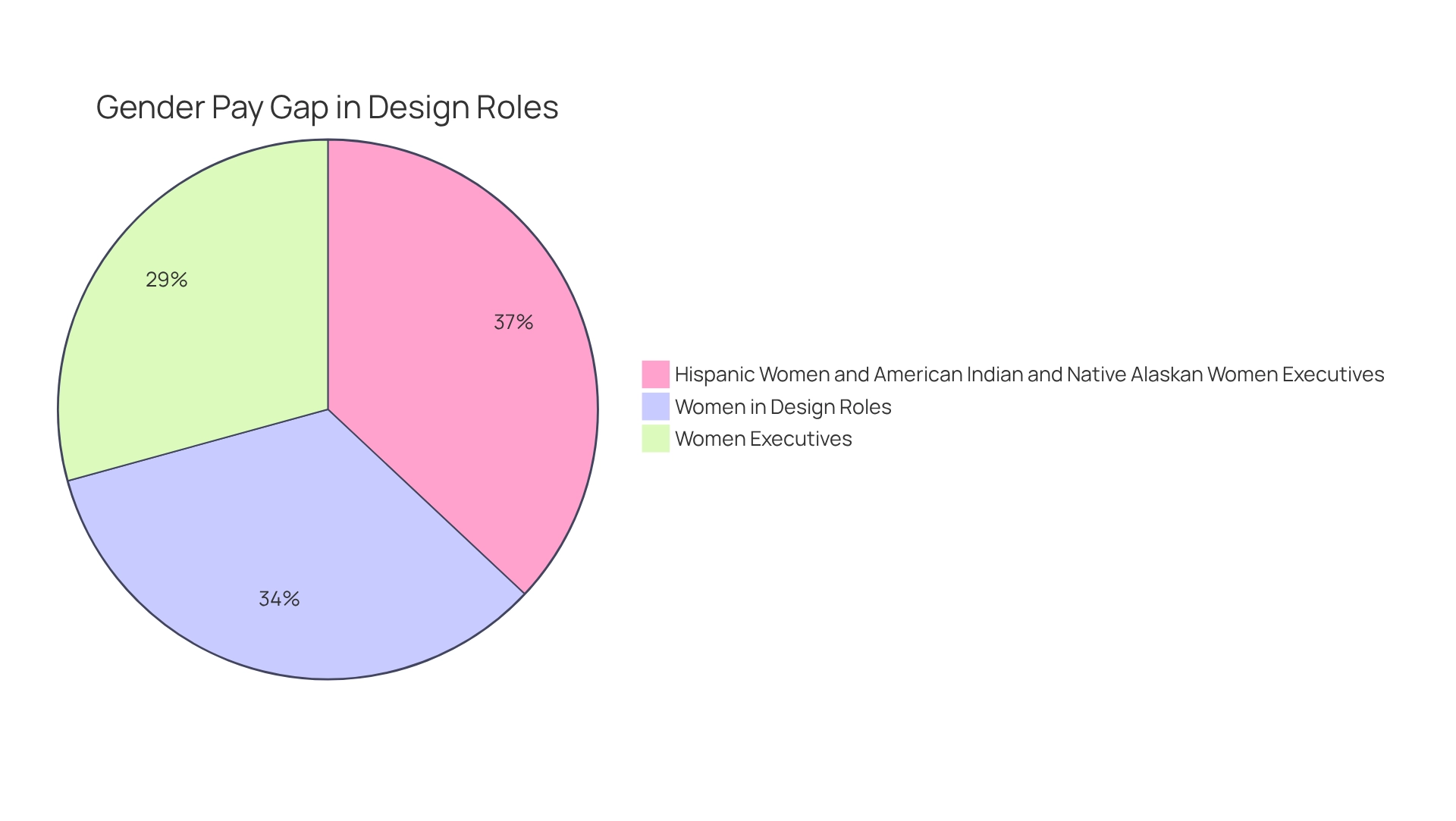
Negotiation Strategies: How to Maximize Your Designer Salary
To effectively maximize your designer salary in 2025, implement the following negotiation strategies:
-
Research the market rates to understand the salary for designers by thoroughly examining the average compensations for your specific role and experience level within your geographical area. Utilize online compensation databases and industry reports to gather accurate data, ensuring you are well-informed about the current market landscape. For instance, candidates are currently pursuing compensation around $125,500, reflecting the competitive nature of the market.
-
Highlight Your Value: Prepare a compelling narrative that showcases your unique contributions and how they align with the company’s objectives. Articulate specific examples of past successes and the impact of your work on previous projects, significantly strengthening your position during negotiations.
-
Practice Your Pitch: Rehearse your negotiation points to build confidence and clarity. Consider role-playing with a trusted colleague or mentor to refine your delivery and anticipate potential counterarguments.
-
Be Open to Alternatives: Acknowledge that pay raises may be constrained by budgetary limitations. In such cases, be prepared to negotiate for additional benefits that enhance your overall compensation package, such as flexible working hours, remote work options, or opportunities for professional development.
-
Leverage Built-In Concessions: Incorporate pre-planned concessions into your negotiation strategy. This approach fosters a perception of mutual gain, making it easier to reach an agreement that satisfies both parties. By demonstrating flexibility, you can enhance your negotiation effectiveness and increase the likelihood of a favorable outcome. As highlighted in the case study “Leveraging In-Built Concessions,” negotiators who incorporate these strategies can facilitate agreement and improve their chances of success.
-
Stay Informed on Market Trends: The job market in 2025 is expected to evolve rapidly due to technological advancements and shifting consumer demands. Staying updated on these trends will help you understand the factors influencing salary expectations and prepare you for discussions about your worth in this dynamic environment. Businesses are encouraged to adopt better negotiation strategies with suppliers to enhance profit and ROI, paralleling the significance of effective negotiation for creators.
As Emily, a graphic designer, expressed, “Thank you for this opportunity. I’m excited about the role and the potential to contribute to your team.” This sentiment highlights the enthusiasm and possible influence of successful negotiation in obtaining a preferred compensation.
By employing these strategies, professionals can navigate salary negotiations more effectively, ensuring they secure a salary for designers that accurately reflects their skills and contributions.
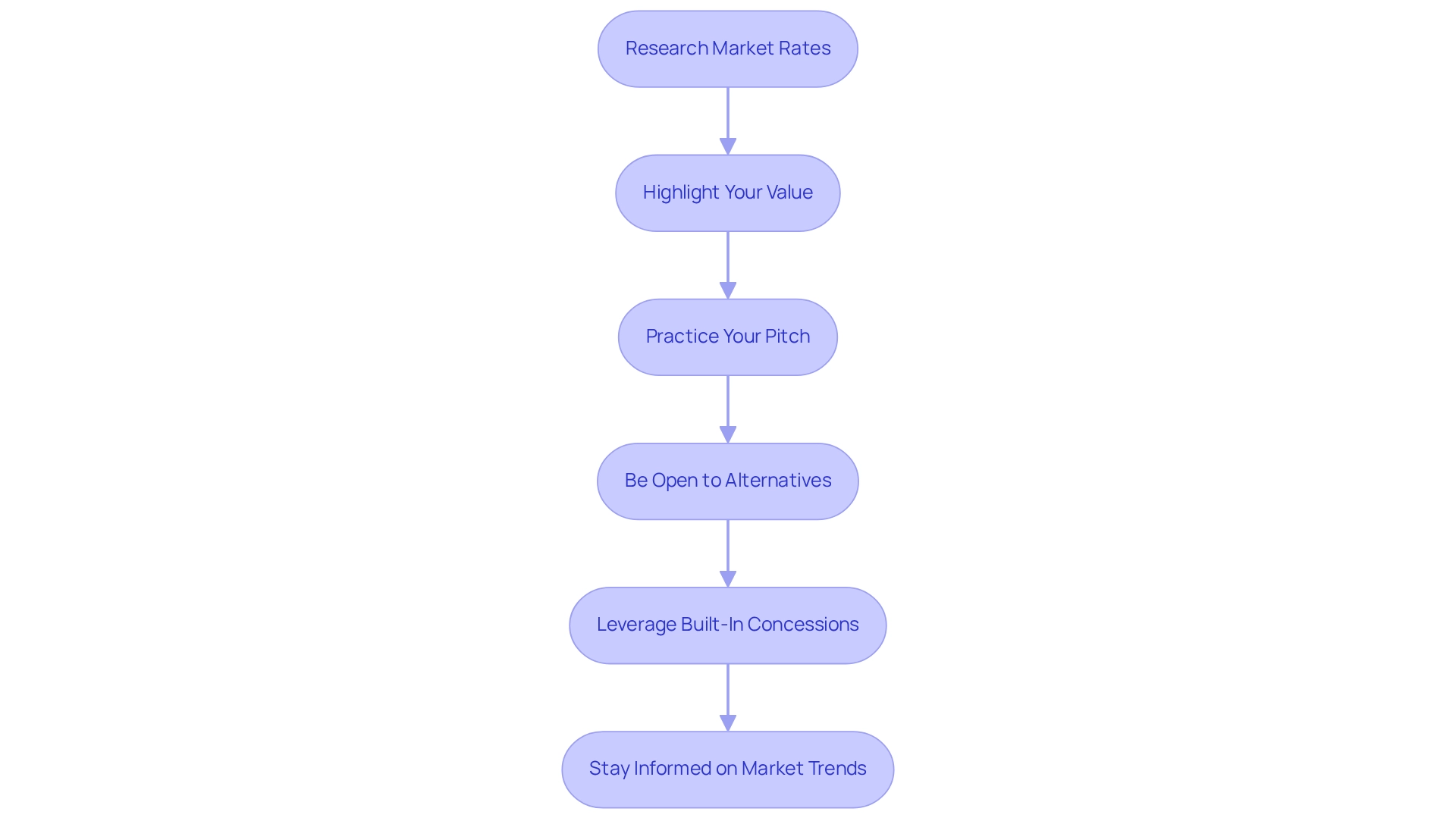
Continuous Learning: Boosting Your Salary Through Skill Development
Investing in continuous learning is essential for designers seeking to elevate their salaries. As industry leader Noah Young states, “The data presented in this report paints a clear picture: effective training and development programs are a cornerstone of any successful organization.” Here are effective strategies to enhance your skills:
- Enroll in Online Courses: Platforms such as Coursera and Skillshare provide a variety of courses focused on the latest design tools and trends. Engaging in these courses equips you with the knowledge necessary to remain competitive in a rapidly evolving field.
- Attend Workshops and Conferences: Participating in industry workshops and conferences not only sharpens your skills but also facilitates networking with professionals. These connections can lead to collaborative opportunities and insights that are invaluable for career growth.
- Stay Updated with Industry Trends: Regularly following blogs and publications relevant to the field is crucial for keeping abreast of new techniques and technologies. This knowledge can significantly enhance your work and ensure that your designs remain relevant.
The significance of continuous learning is further underscored by expert insights, emphasizing that effective training and development programs are foundational to success. Moreover, the rise in Learning and Development (L&D) compensation signifies their increasing strategic value in organizations, offering a fulfilling career trajectory for adaptable professionals.
Statistics reveal that the salary for designers, particularly senior UI professionals in Canada, stands at an impressive $107,500, underscoring the financial benefits of skill enhancement. Success stories abound, with many designers reporting substantial salary increases after completing targeted courses. For instance, a thorough campaign for Quaker Oats, created by WonderEight, showcased how creative concepts and technology can elevate brand perception and market presence.
The skills acquired through continuous education were pivotal in the success of this campaign, further illustrating the tangible benefits of ongoing learning.
In 2025, the most sought-after skills in creativity include proficiency in user experience (UX) design, motion graphics, and digital marketing strategies. By focusing on these areas through online classes and career growth opportunities, professionals can position themselves for increased earnings, particularly in designer salaries, and enhanced career progression. To maximize earning potential, L&D professionals should invest in advanced education and cultivate strategic skills.
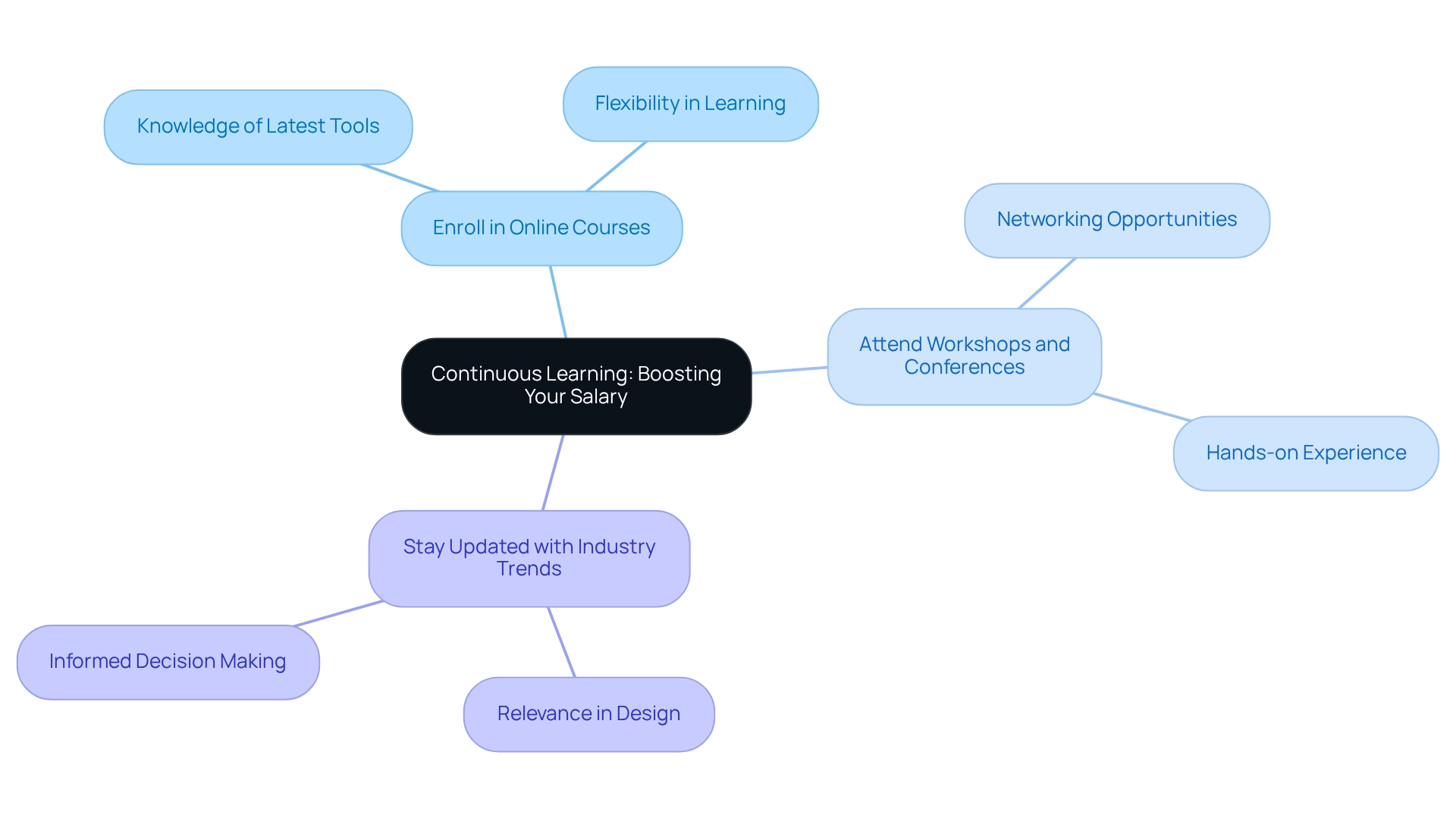
Key Takeaways: Maximizing Your Earnings as a Designer
To maximize your earnings as a designer in 2025, consider the following strategies:
- Understand the Salary Landscape: Familiarize yourself with the average salaries for your specific design role, including motion and digital design. Research indicates that collaborating with brands can lead to high-profile projects and lucrative income streams, empowering you to make informed decisions about your career trajectory.
- Geographical Influences: Recognize how location impacts compensation. Designers in major urban centers often receive greater compensation due to heightened demand and cost of living. Thus, consider this when assessing job offers or freelance opportunities.
- Address the Gender Pay Gap: Be proactive in advocating for equitable compensation. Research indicates that awareness and negotiation can significantly diminish the gender pay gap in creative positions, ensuring fair compensation for everyone.
- Effective Negotiation: Develop strong negotiation skills to secure better offers. Prepare to articulate your value and leverage market data to support your requests during salary discussions.
- Invest in Continuous Learning: Stay ahead in the competitive design landscape by continually enhancing your skills. As Gail Doby, co-founder of Gail Doby Coaching & Consulting, states, “This is my favorite time to dive into self-improvement books, clean the closets, organize for the year and read fun books.” Engaging in professional development not only increases your marketability but also opens doors to higher-paying opportunities.
- Explore Freelance Platforms: Utilize platforms like Upwork and Fiverr to access a global marketplace, expanding your opportunities and income potential.
- Consider Brand Kits: Designing and selling brand kits can be a lucrative avenue. These kits are crucial for companies aiming for a unified visual identity, enabling creators to generate scalable revenue while offering valuable resources that improve clients’ branding initiatives.
- Stay Informed on Industry Trends: Keep an eye on current trends, such as the on-demand digital program that helps individuals transition from hired-gun to highly valued brand strategist in less than 30 days. This highlights the importance of evolving skill sets for financial success.
By applying these strategies, you can greatly enhance your financial results as a creative professional, positioning yourself for success in the evolving market of 2025. Success stories abound, with many designers leveraging these approaches to achieve remarkable salaries and financial stability.
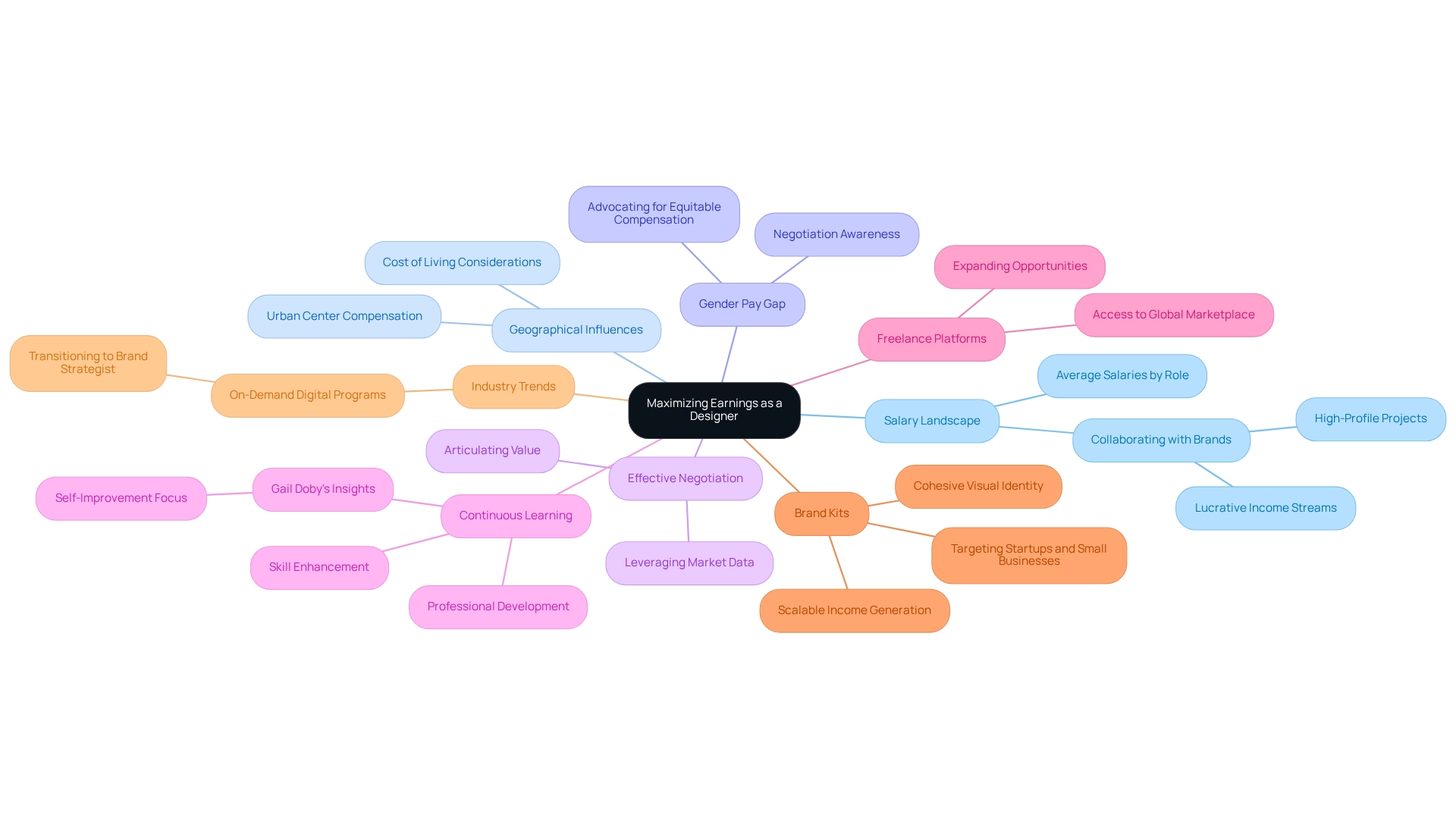
Conclusion
The salary landscape for designers in 2025 is significantly influenced by various factors, such as specialization, geographical location, and the persistent gender pay gap. Notably, UX/UI designers are leading this trend, often commanding higher salaries due to the surging demand for user-centered design. Additionally, the rise of remote work has reshaped salary negotiations, enabling designers to leverage a wider market perspective and optimize their earnings.
Geographical disparities indicate that designers in major metropolitan areas typically earn considerably more than their counterparts in smaller cities, highlighting the critical role of location in evaluating potential compensation. Moreover, the gender pay gap remains a pressing concern, with women earning substantially less than men in similar roles, particularly at the executive level. Tackling this disparity necessitates concerted efforts from employers to foster equitable pay practices and support women’s career advancement.
To effectively navigate this intricate landscape, designers are urged to implement robust negotiation strategies, stay abreast of market trends, and commit to continuous learning. By grasping the salary dynamics, advocating for fair compensation, and enhancing their skill sets, designers can strategically position themselves for greater financial success. Ultimately, maximizing earnings hinges on being proactive, well-informed, and adaptable in an industry that is rapidly evolving.
Frequently Asked Questions
What factors influence designer salaries in 2025?
Designer salaries in 2025 are influenced by factors such as experience, specialization, geographic location, and the evolving market landscape.
What is the typical salary range for designers in the U.S.?
Salaries for designers in the U.S. typically range from $50,000 to over $120,000, reflecting the diversity of roles and locations.
Which design professionals command higher salaries?
UX/UI professionals often command higher salaries due to the growing demand for user-centered solutions in digital products.
What is the average salary for a UX researcher?
The average salary for a UX researcher is around $91,000 annually.
How has remote work impacted designer salaries?
Remote work has transformed the salary landscape, allowing designers to negotiate salaries based on a broader market perspective rather than being confined to regional standards, thus increasing earning potential and job opportunities.
What percentage of graphic artists hold a bachelor’s degree?
Approximately 60% of graphic artists hold a bachelor’s degree, while 21% enter the field without formal education.
What are the average earnings for graphic artists and their potential?
The average income for graphic artists ranges from $50,000 to $80,000, with entry-level positions starting at around $40,000. The 90th percentile annual income can reach up to $100,450.
What is the salary range for UX professionals?
UX professionals typically earn between $80,000 and $130,000, with senior roles exceeding $150,000.
How much do web creators earn on average?
Web creators generally earn between $60,000 and $100,000, depending on their skill set and experience level.
Why is it important for designers to stay informed about salary trends?
Staying informed about salary trends and the impact of specialization is crucial for designers aiming to negotiate their worth and make strategic career decisions in a competitive job market.



